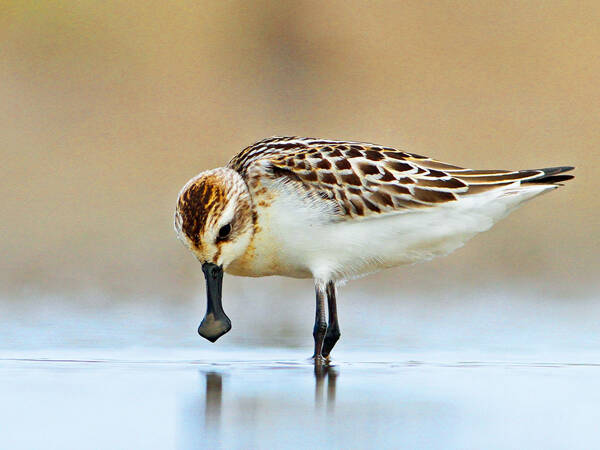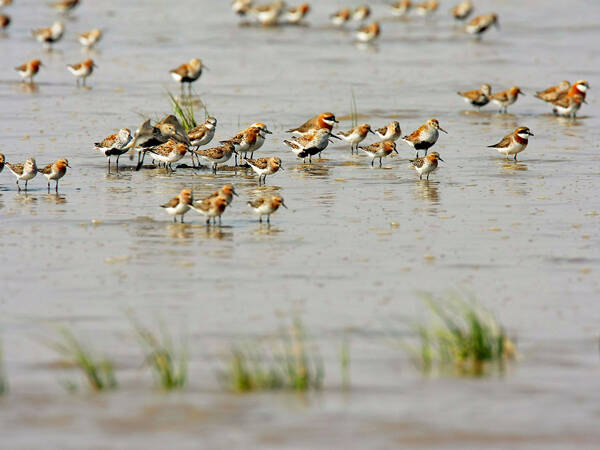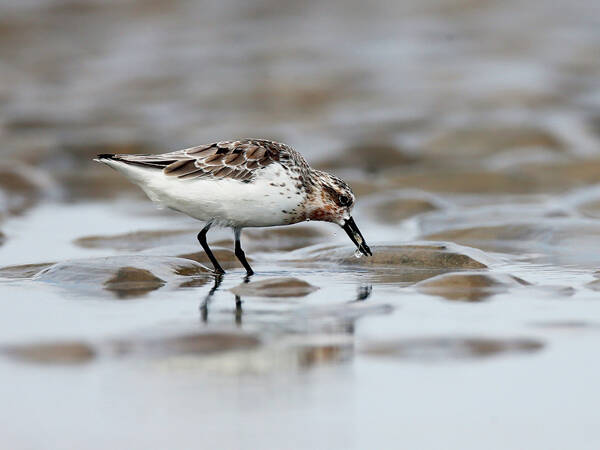Calidris pygmaea
IUCN
LCBasic Information
Scientific classification
- name:Calidris pygmaea
- Scientific Name:Calidris pygmaea,Shoveler,Spoon-billed Sandpiper
- Outline:Wading birds
- Family:Charadriiformes Piperidae S.Sandpiper
Vital signs
- length:14-16cm
- Weight:
- lifetime:
Feature
The beak is black, with a flat base and a shovel-shaped tip. Because its beak looks like a small black spoon, it is called "the bird with its own rice spoon".
Distribution and Habitat
Monotypic species, population size 100-220 breeding pairs. Breeding in the coastal areas of far northeastern Russia. Wintering in the coastal areas from south of Zhejiang to Southeast Asia and South Asia. Migrating through the coastal areas of Russia, Japan, the Korean Peninsula and China, of which the largest known migratory population passes through Dongtai and Rudong, Jiangsu in spring and autumn. A small number of first summer plumage individuals spend the summer in Dongtai. Some winter records in inland areas of my country and north of Zhejiang are questionable.
Spoon-billed sandpipers mainly inhabit the shores of tundra swamps, grasslands and lakes, streams, ponds and other water bodies on the Arctic coast during the breeding season. In the non-breeding season, they mainly inhabit the shallows and muddy ground in the coastal and estuary areas, or the edge of the water body near the coast, and do not go deep into inland waters.
Appearance
A small sandpiper similar to the Red-necked Knot, but slightly larger, with a slightly larger head, a shorter body at the back, and longer legs. The tip of the bill is flat and spade-shaped. When viewed from the side, the spade shape is almost invisible and slightly upturned; the bill is longer than that of the Red-necked Knot, and is thicker from the base to the tip, while the Red-necked Knot's beak tapers rapidly from the base to the tip, making it thinner overall. The Three-toed Sandpiper also has a thicker beak, and it should be noted that it is significantly larger than the Spoon-billed Sandpiper.
Details
Spoon-billed Sandpiper breeds in the tundra, and is more common in coastal wetlands during migration and wintering. If the first clutch of eggs is lost in the early breeding period, a second clutch of eggs will be laid, so conservationists are allowed to collect the first clutch of eggs for artificial rearing. Due to its special beak shape, its main way of foraging is to move the tip of the beak left and right or back and forth like a vacuum cleaner in shallow water to filter food; or sometimes lift the beak off the water surface like a sand cone and insert it vertically downward into the water. Therefore, it is not common to find it mixed with Red-necked Sandpiper when foraging on the mudflats: Spoon-billed Sandpiper is more likely to appear in places with accumulated water on the mudflats, while Red-necked Sandpiper is often seen in drier places on the surface of the mudflats. In addition, Red-necked Sandpiper more often forages in inland wetlands where Spoon-billed Sandpiper rarely visits. When roosting at high tide, Spoon-billed Sandpipers prefer to mix with slightly larger species such as Black-bellied Sandpipers, Sand Plover, Three-toed Sandpipers, etc., but not always with Red-necked Sandpipers.

Spoon-billed Sandpipers often move alone in shallow water and soft muddy ground. When walking, they often lower their heads and constantly put their mouths into the water or mud, sweeping their mouths back and forth in the water or mud while walking, and even when turning back, they don’t need to take their mouths out of the water.
Diet: Mainly feeds on insects, insect larvae, crustaceans and other small invertebrates. The main way of foraging is to use the mouth to sweep back and forth in the water or mud to find food. Sometimes it also pecks directly on the ground.
Migration: Mainly migratory birds in China, some winter migratory birds. Migrate through China in spring from April to May and in autumn from September to October.

Spoon-billed sandpiper breeds in the coastal tundra of northeastern Siberia, with a breeding season of June to July. It nests in tundra swamps, lakes, ponds, stream banks, coastal tundra and grasslands. It especially likes to nest in mossy grasslands by freshwater ponds. The nest is very simple, mainly made by the parent bird digging a circular pit in the soft tundra, which is padded with moss, dead grass and willow leaves. Each nest lays 3-4 eggs. The eggs are light brown in color with small brown spots. The size of the eggs is 28-33 mm × 20-23 mm.
The distribution area of the Spoon-billed Sandpiper is narrow and the number is small. The estimated breeding population is 200-2800 pairs (Kolosov, 1983).
In March 2020, the Guangdong Provincial Forestry Bureau reported that 34 Spoon-billed Sandpipers were found in the Guangdong Zhanjiang Mangrove National Nature Reserve. They have been eating on the mudflats for several days to reserve energy for their migration journey. As one of the rarest birds in the world, there are about 210 to 228 breeding pairs of spoon-billed sandpipers, far fewer than giant pandas. This is a small wading bird that breeds in the permafrost zone in northeastern Russia and winters in wetlands in East and Southeast Asia.

On April 5, 2021, a critically endangered spoon-billed sandpiper was monitored in the Xuanmen Bay Wetland in Yuhuan, Zhejiang. This spoon-billed sandpiper is a wild female bird banded in the breeding grounds of Chukotka, Russia in 2016. It uses its spoon-like beak to dip into shallow water to eat and store energy for migration.
From October 8 to 10, 2021, the special program "Looking for Spoon-billed Sandpiper" on CCTV's all-media platform was broadcast for three consecutive days, focusing on the vivid practice of implementing Xi Jinping's ecological civilization thought in Yancheng, Jiangsu.
In November 2021, Haikou Lanjia Wetland Research Institute released a message introducing that Spoon-billed Sandpiper was recently found visiting Danzhou Bay, Hainan. Among them, a Spoon-billed Sandpiper with rings was photographed and recorded. This is the first time that a Spoon-billed Sandpiper with rings has been found in Hainan, which is of great significance for studying the population size and habits of Spoon-billed Sandpiper.
On September 25, 2022, investigators from the Fujian Birdwatching Association observed a Spoon-billed Sandpiper during a bird survey in the Minjiang Estuary Wetland. This is the first time that this globally endangered species has been recorded in Fujian Province this autumn and winter.
On November 17, 2022, many rare migratory birds flew to Weitou Bay, Jinjiang, Fujian, for wintering, including the endangered bird spoon-billed sandpiper (yù).

This species is listed as critically endangered because its numbers are so low and it is experiencing an extremely rapid decline. This is because of a number of factors, including habitat loss in breeding, passage and wintering grounds, which are all affected by disturbance, pollution, hunting and climate change. Fledglings are consistently low, leading to concerns about rapidly aging populations; urgent action is needed to prevent this species from extinction.
Listed in the Red List of Endangered Birds of the World of Birdlife International (CBP).
Listed in the "National List of Terrestrial Wildlife with Important Economic and Scientific Research Value" (Item 171) issued by the State Forestry Administration of China on August 1, 2000.
Listed in the "Red List of Endangered Species of the World Conservation Union" (IUCN) 2018 ver 3.1-Critically Endangered (CR).
Listed as the first-level "National Key Protected Wildlife List" (February 5, 2021 [15]).
Domestic and foreign parties have cooperated in the protection of Spoon-billed Sandpiper, and have achieved remarkable results in special research, habitat protection and public publicity, curbing the rapid decline of the Spoon-billed Sandpiper population by nearly 26% per year. In recent years, the population has basically stabilized at 700-800.








